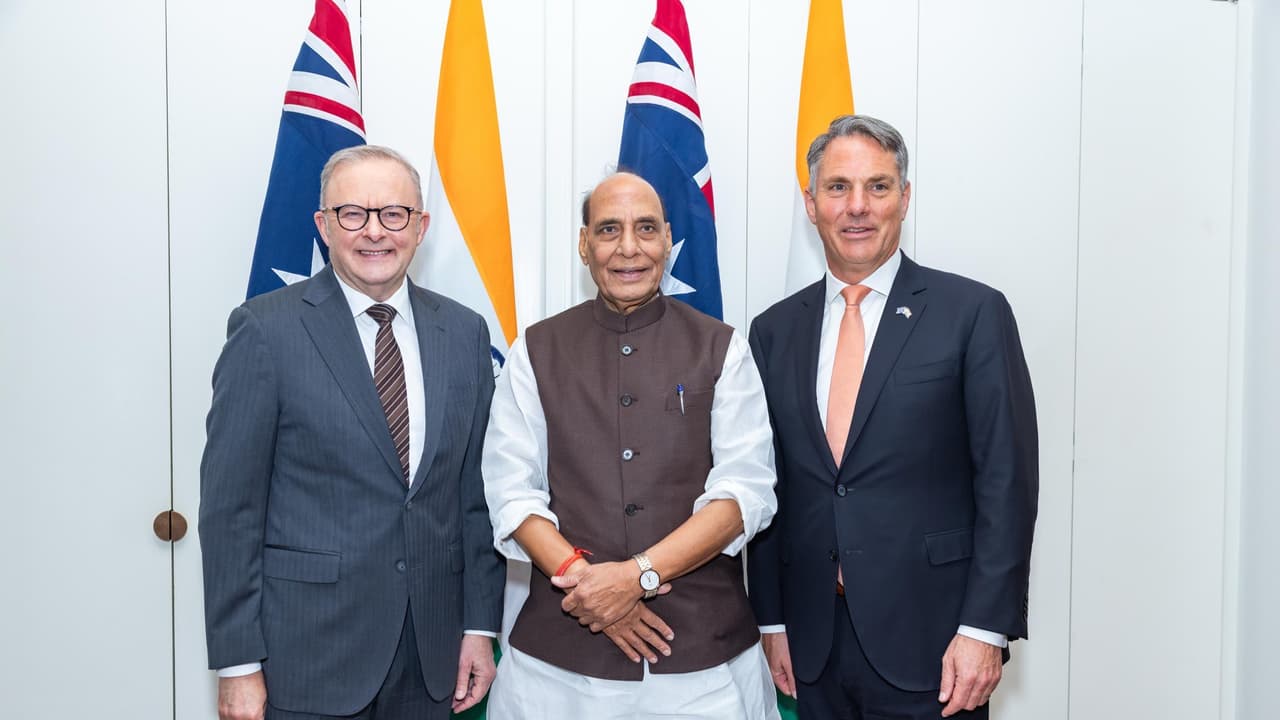India and Australia held their inaugural Australia–India Defence Ministers’ Dialogue and inked three memorandum of understandings (MoUs) in the field of information sharing, submarine rescue and establishment of joint staff talks.
New Delhi: With an ambition to further enhance the bilateral defence cooperation, India and Australia on Thursday held their inaugural Australia–India Defence Ministers’ Dialogue at Canberra in Australia and inked three memorandum of understandings (MoUs) in the field of information sharing, submarine rescue and establishment of joint staff talks.
India’s defence minister, Rajnath Singh, who is currently in Australia on a 2-day visit, discussed a number of topics pertaining to defence ties between two countries and further scaling up the ties with like-minded countries, with his Australian counterpart Richard Marles.
The first-ever Australia–India Defence Ministers’ Dialogue reflected “unprecedented” progress in the bilateral defence partnership. The development took place following the four bilateral meetings between the ministers since the elevation of the Australia–India Comprehensive Strategic Partnership in 2020.
India offered maintenance, repair and overhaul of Royal Australian Navy ships in Indian shipyards during their deployment to the Indian Ocean Region.
During their meeting, the two defence ministers reiterated to expand the bilateral defence architecture and enhance consultation and cooperation by conducting an annual Defence Ministers’ Dialogue.
The ministers welcomed the signing of the Australia–India Implementing Arrangement on mutual submarine rescue support and cooperation, the establishment of Joint Staff Talks as a forum to progress joint exercises, operations and interoperability across all domains and closer cooperation on information sharing.
Rajnath Singh and his Australian counterpart also appreciated the progress made towards operationalizing the Australia–India Implementing Arrangement on Air-to-Air Refuelling signed in 2024. They also welcomed the growing frequency and complexity of defence exercises and exchanges and the increasing interoperability through implementation of the Mutual Logistics Support Arrangement.
Australia has invited Indian Navy to participate in submarine rescue exercise Black Carillon and also invited Indian Air Force for Exercise Talisman Sabre in 2027.
The two leaders also welcomed additional Indian students at the Australian Defence College in 2026, and a position at the Australian Defence Force Academy in 2027 for the first time.
“Both sides also agreed to pursue defence collaboration in contemporary technology, including through the Joint Working Group on Defence Industry, Research and Materiel,” an official said.
In a message to China, which has been behaving belligerently in the region, the two ministers affirmed the importance of enhancing cooperation with regional partners to help maintain a free, open, peaceful, stable and prosperous Indo-Pacific also underscored their strong support for freedom of navigation and overflight, unimpeded trade in the region, and other lawful uses of the sea consistent with international law, particularly the 1982 United Nations Convention on the Law of the Sea. They also agreed to continue aircraft deployment from each other’s territories to build operational familiarity and also welcomed the ongoing cooperation under the Australia–India–Indonesia trilateral format to address common challenges. Quad
They welcomed the ongoing progress in defence cooperation among Australia, India, Japan and the United States, underscoring the growing strategic convergence among the partners.
They reaffirmed their commitment to enhancing collaboration on maritime domain awareness and looked forward to a second collaborative activity on the margins of Exercise Malabar in November 2025.
Australia and India expressed strong support for initiatives that advance closer maritime surveillance cooperation among the four partners.
